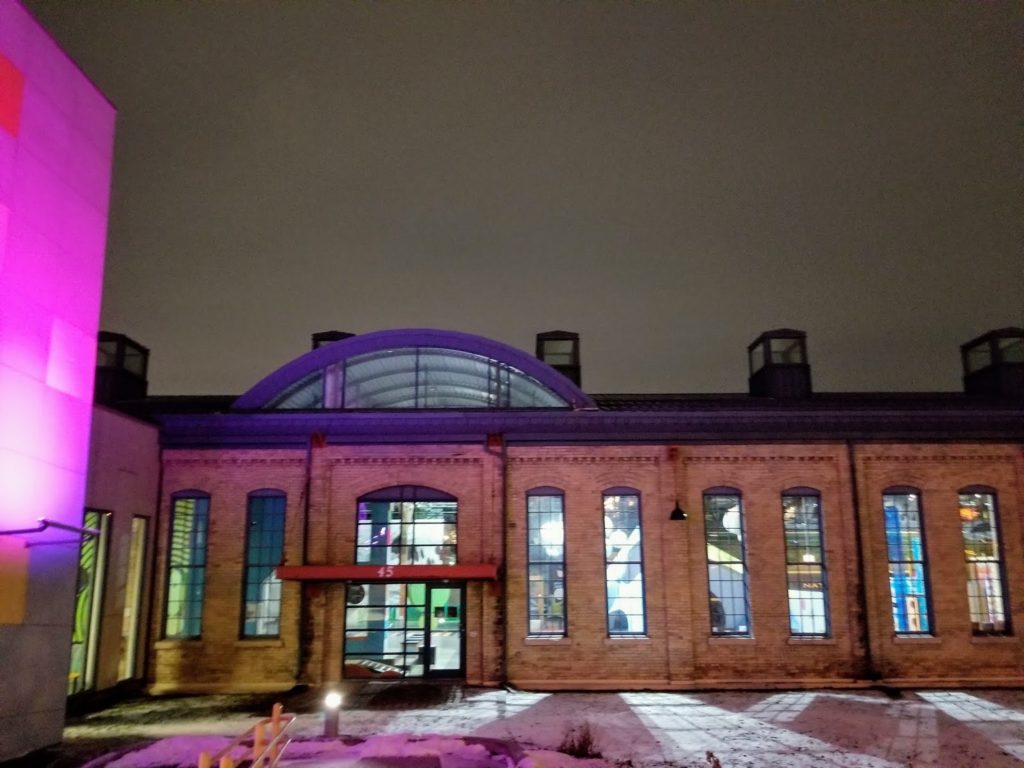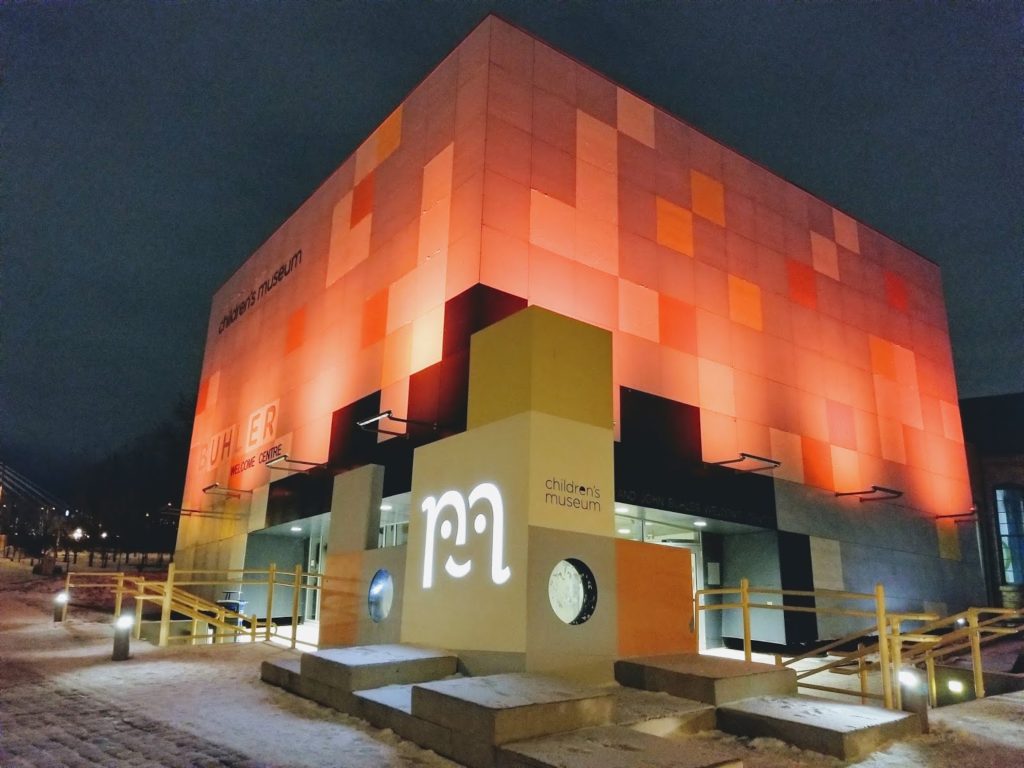
/ Blog
November 29, 2019
An Industrial Rehabilitation: The Making of the Manitoba Children’s Museum
A familiar haunt for family outings, school trips, and birthday parties the Manitoba Children’s Museum (45 Forks Market Road) has been a mainstay of the Forks since they took over CNR Bridges and Structures Building in 1994.
This was not the easiest of transitions to make; The CNR Bridges and Structures building is the oldest still-standing structure in the Forks and had been built as a repair station for trains. It was definitely not built to act as a playground and learning center for children. Years of disuse leading up to 1994 added the additional challenge of bringing the building back up to code. It was a daunting task, but enough people saw potential in the abandoned repair shop to bring new life back to an old building.
When the CNR Building opened in 1889, it was part of a larger complex built at the Forks site. Owned by the Northern Pacific and Manitoba Railway, this would include a train station, hotel, and two freight sheds. At the time, railroads were expanding rapidly across western Canada and companies flocked to Winnipeg to take advantage of the growing industry. Across 1888-1892, rail companies spent $400,000 on the construction of new rail buildings in Winnipeg alone. Among these new builds was the CNR Bridges and Structures building, which was designed by John Woodman and built by contractors Rourke and Cass.
Woodman’s design for the building was purely utilitarian, which features primarily white brick with a concrete base. It is a simple rectangular structure, standing one storey tall with large exterior doors to accommodate the train cars that once ran through the building. At the time of construction, four rail lines ran guided trains through the structure. The building also featured a roundhouse, which was one-of-a-kind in Canada at the time. Driving into the roundhouse, train cars would be placed on a turntable that would rotate them to one of 8 repair stalls. By 1901, Northern Pacific and Manitoba Rail were bought out by CN Rail, who took on management of the CNR Bridges and Structures Building.
Over the course of its next 50 years of operation, interior elements would come and go. A blacksmith shop was replaced by a boiler room by 1902, and in 1946 staff facilities, including lunch rooms, locker rooms, and new staff toilets were added to the structure. These wound up being the last additions to take place on the property for many years.
The rail economy that Manitoba was built on did not last forever. By the 1930s a combination of factors including the opening of the Panama Canal, onset of the Great Depression, and the growth of the automobile industry led to a decline in interest in rail transport across Canada. Slowly but surely, massive railyard facilities began to close.
The CNR Bridges and Structure’s building’s death was a slow one, as parts of the building became defunct and were then demolished. The building’s roundhouse, once a unique part of the structure, was largely useless by 1918 and torn down by 1936.
By the mid-70s, then, the CN Railyard at the Forks was in a slump. Buildings were vacant, rail travel was down, and The Forks was in need of a change. In an effort to develop the massive swath of land on the site, a tri-level renewal group (The Forks Renewal Corporation) was created in 1986– with intentions to redevelop the Forks as a “meeting place” along the river. With this new plan came the reopening of the Johnston Terminal and the creation of the Forks Market
Shortly after the Forks redevelopment had begun, the Manitoba Children’s Museum began to look for a new home. The Children’s Museum was relatively new still, having opened in 1986 in a warehouse at 109 Pacific Avenue, but they were already looking for new ways to develop. The CNR Building may have not have seemed like the most natural fit for them (the Children’s Museum had initially considered moving into Portage Place Mall), but the large space and the potential for outdoor programming was enticing.
The Children’s Museum board and staff were not the only ones interested in the project. All three levels of government offered financial assistance toward the redevelopment of the CNR Building. Renovations of the CNR Building, described then as “vacant and run down”, were estimated to cost around $4.1 million as of 1992. The Government of Canada contributed $1.5 million, the Province of Manitoba $1 million, and the City of Winnipeg $800,000 along with tax breaks. Other groups, Western Economic Diversification Canada and Manitoba’s Culture, Heritage and Citizenship Department also agreed to contribute $1 million each to the project.
Outspoken public support helped matters along. Manitoba Heritage Minister Bonnie Michelson spoke positively about the move, as did then-Mayor Bill Norrie. Both saw the redevelopment of the CNR Building as a chance to bring a new attraction to the Forks, and as a means of bringing an old building back to life.
Still, the project didn’t come without challenges. The CNR Building was not in great shape, and the years of disuse were evident. “Squirrels, birds and raccoons were the only occupants,” claimed the project’s architect Keith Rankin in a Winnipeg Free Press interview on May 28th 1994.
The entire roof needed to be replaced. The peaked roof that originally capped the building burned in a 1939 fire, and the flat mansard replacement used timbers which had begun to fail by the 1990s. Further, the foundation needed additional support during the construction process, and layers of mud and grime covered much of the interior. Understandably, the disarray prompted debates about the value of saving the building at all.
Jane Eisbrenner, the Children’s Museum’s Executive Director at the time, expressed having doubts about the project in a letter published shortly before the museum’s 1994 opening:
Keith Rankin, alongside the firm of Cooper Rankin Architects, created a new design that blended the historic structure with new upgrades. The new windows mimic the original ones, and skylights replaced the old steam vents on the roof. The original massive gates that allowed trains entrance in the 1890s were fixed up to allow an opening for large exhibit pieces.
 |
| The old train entrance now allows natural lighting into the building, but also fits the 1952 diesel train that runs throughout the museum in 2019. Source: Sabrina Janke for Heritage Winnipeg |
 |
| The Manitoba Children’s Museum in 2019, note the skylights along the roof that resemble old steam vents in 2019. Source: Sabrina Janke for Heritage Winnipeg |
Fred Penner, present at the opening of ceremonies, wrote a song to commemorate the sod turning for the new Museum in June 1993, and finished his song with the verse: “This museum for the children will be a part of our lives forever more.”
 |
| The new entrance to the Children’s Museum in 2019. Source: Sabrina Janke for Heritage Winnipeg |
Heritage Winnipeg Files
City of Winnipeg Historic Building Report
AMUSE Magazine, Summer 1994.
Winnipeg Free Press.
THANK YOU TO THE SPONSOR OF THIS BLOG POST:

Written by Sabrina Janke on behalf of Heritage Winnipeg.













Wow cool. This makes me want to go to the children's museum!!